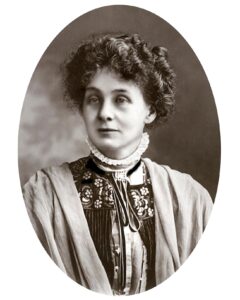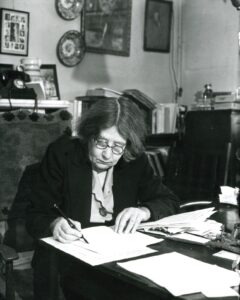Sylvia Pankhurst by Rachel Holmes, review — finally having her moment.
Her mother and sister were once better known, but this fine biography shows just how remarkable the women’s rights activist was.
September 22, 2020
After decades of obscurity, Sylvia Pankhurst is finally having her moment. This is the third biography in seven years — not bad for a woman who spent much of her life being unfavourably compared with her more popular mother and sister.
The neglect is partly owing to Sylvia’s rich, complex life not being easily pigeonholed. Although she played an instrumental role in the suffrage movement, she was first and foremost a defender of the poor, the oppressed and the marginalised. Her political choices were often noble, but lonely ones.

Sylvia’s mother, the suffragette Emmeline Pankhurst
ALAMY
Despite financial troubles and career disappointments, the Pankhurst parents were a devoted couple and the household a happy one. Sylvia was born in 1882, the second of five children and the middle daughter between Christabel (her mother’s favourite) and Adela (no one’s favourite). She craved Emmeline’s good opinion, but was closer to her father. “Life is valueless without enthusiasms,” he once told her, a piece of advice she took to heart.
Sylvia was only 16 when her father died. Without his counter-influence, the three sisters (and their brother, Harry, who died of polio aged 20) lived in thrall to their powerful mother. After Emmeline and Christabel founded the Women’s Social and Political Union (WSPU) in 1903 — having become frustrated by the lack of support from the Independent Labour Party — there was no question that Sylvia and Adela would do anything other than sacrifice their personal interests for the good of the cause. Sylvia later admitted that one of her greatest regrets was being made to give up a promising art career for politics.
She was imprisoned for the first time in 1906. As the tactics of the WSPU became more extreme, so did the violence employed by the authorities against its members. Sylvia was the only Pankhurst to be subjected to force-feeding, an experience she likened to rape.
“Infinitely worse than the pain,” she wrote of the experience, “was the sense of degradation.” Indeed, in some cases that was the whole point of the exercise. While not widespread, vaginal and anal “feeding” was practised on the hunger strikers. Holmes hints, but doesn’t speculate that Sylvia may have been one of its victims.

Pankhurst died in Ethiopia in 1960 after accepting an invitation from Emperor Haile Selassie, pictured, to emigrate to Africa
PHOTO ARCHIVE/GETTY
Ironically, Sylvia suffered the most while being the least convinced by the WSPU’s militant tactics. It wasn’t only the violence she abhorred. Emmeline and Christabel wanted the WSPU to remain an essentially middle-class, politically aloof organisation, whereas Sylvia regarded women’s rights as part of a wider struggle for revolutionary socialism. The differences between them became unbridgeable after Sylvia founded a separate socialist wing of the WSPU in the East End. Both she and Adela, whom Emmeline and Christabel dismissed as a talentless lightweight, were summarily expelled from the WSPU in February 1914. The four women would never again be in the same room together.
Sylvia had recognised early on that first-wave feminism suffered from a fundamental weakness. It was simultaneously too narrow and too broad to be a stand-alone political platform. The wildly different directions that were taken by the four Pankhursts after the victory of 1918 proved her right: Emmeline became a Conservative, Christabel a born-again Christian, Sylvia a communist and Adela a fascist, yet all remained loyal to their concept of women’s rights.
Once cut loose from the Pankhurst orbit, Sylvia claimed the freedom to think and act as her conscience directed. In 1918 she fell in love with an Italian anarchist socialist refugee, Silvio Corio, who already had three children with two women. Undeterred, she lived with him in Woodford Green, Essex, in a ramshackle home appropriately named Red Cottage. They remained partners for the best part of 30 years, writing, publishing and campaigning together. Even more distressing for her uptight family, not to mention society in general, at the advanced age of 45 she had a son by him, Richard, who was given her surname rather than Silvio’s.

Sylvia Pankhurst, here in 1940, became a communist after the victory of 1918
ALAMY
Broadly speaking, her life can be divided into four campaigns: after women’s suffrage came communism, then anti-fascism and finally Ethiopian independence. (The last has received the least attention, although Sylvia insisted it gave her the greatest pride.) None was an unalloyed success or without controversy. Her fierce independence would lead her to break with Lenin over their ideological differences, and later support her erstwhile enemy Winston Churchill when their views on fascism aligned. She never had any time for Stalin, left-wing antisemitism or liberal racism. In her mid-seventies and widowed, she cut all ties with Britain by accepting an invitation from Emperor Haile Selassie to emigrate to Ethiopia. She died there in 1960.
The genius of Holmes’s fascinating and important biography is that it approaches Sylvia’s life as if she were a man. The writing isn’t prettified or leavened by amusing anecdotes about Victorian manners, it’s dense and serious, as befits a woman who never wore make-up and didn’t care about clothes. To paraphrase the WSPU’s slogan, it is about deeds not domesticity. Rather than dwelling on moods and relationships, Holmes is interested in ideas and consequences. It’s wonderfully refreshing. Sylvia lived for her work; her literary output was astounding. In addition to publishing her own newspaper almost every week for over four decades, she wrote nonfiction, fiction, plays, poetry and investigative reports. She even taught herself Romanian so that she could translate the poems of the 19th-century Romantic poet Mihail Eminescu. It doesn’t matter whether Sylvia was right or wrong in her political enthusiasms; as Holmes rightly insists, what counts is that by acting on them she helped to make history.





